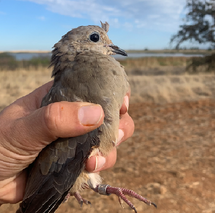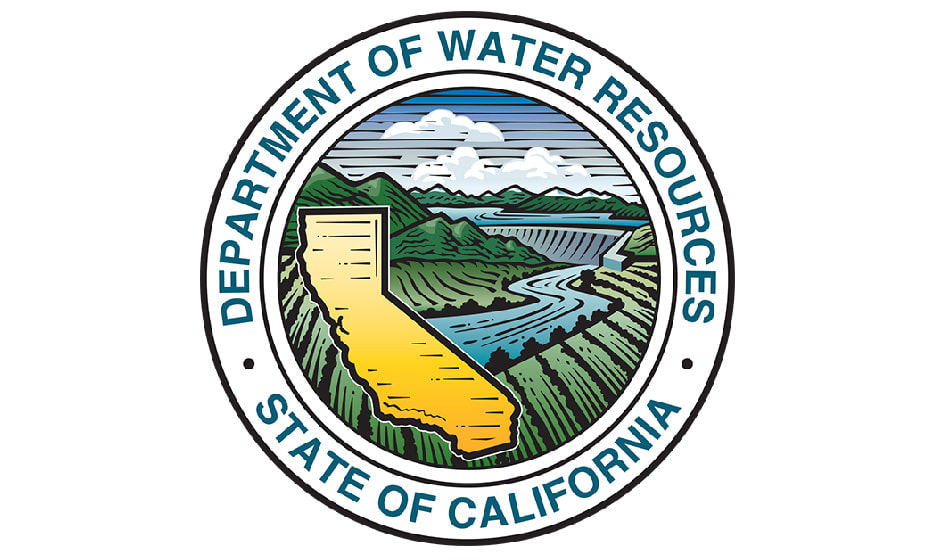 August 19, 2022 Tracking Dove Populations Staff from the California Department of Fish and Wildlife (CDFW), along with assistance from California Department of Water Resources (DWR) staff, have been in the Oroville Wildlife Area (OWA) since July 11 to collect information on the local mourning dove population. Working in the safflower and sunflower fields in the OWA, that were planted by CDFW staff to provide a readily available food source for doves and many other bird species, staff successfully captured and placed identifying bands on 33 doves. Mourning doves are an important migratory game bird and California is one of 39 states participating in a national effort to monitor the mourning dove population in order to better estimate annual survival and guide harvest-management decisions. CDFW and DWR staff record the sex and approximate age of each banded bird and place a metal band with a unique identification number and a toll-free phone number to report the band around the dove’s leg. The hunter is the critical link in the dove banding study. Their reporting of the dove’s leg band enables wildlife managers to understand the effects of annual hunting regulations on mourning dove populations and allows for greater understanding of their migratory patterns. The Oroville Wildlife Area is a popular hunting location and CDFW expects 80 to 100 opening day hunters when Dove season opens on Sept. 1. For more information on CDFW activities in the OWA to increase forage for local and migratory birds, visit the DWR Updates webpage and search “sunflower” to access the digital article and previous stories in the Lake Oroville Community Update newsletter.  CHINOOK SALMON RETURN TO THE FEATHER RIVER Chinook salmon are completing their life cycle and returning home to the Feather River to lay eggs for the next generation of salmon. The Feather River Fish Hatchery plans to open up the fish ladder the week of Sept. 12 to begin hatchery spawning operations which enables millions of Chinook salmon to be released to the river every spring. Visitors to the Hatchery’s Fish Barrier Dam Overlook Viewing Area can watch salmon jumping and after the fish ladder opens in mid-September, visitors can watch salmon swim up the ladder at the Underwater Viewing window. The Overlook is located off Table Mountain Boulevard north of the Hatchery. Visitors are also encouraged to visit the Hatchery (open daily 8 a.m. to 3 p.m.) and attend the 28th Annual Salmon Festival in Oroville on Sept. 24. WATER SUPPLY STRATEGY Last week, Governor Gavin Newsom announced California’s latest actions to increase water supply and adapt to more extreme weather patterns caused by climate change. The actions, outlined in a strategy document called “California’s Water Supply Strategy, Adapting to a Hotter, Drier Future” (Strategy), follows $8 billion in state investments over the last two years to help store, recycle, de-salt, and conserve the water needed to keep up with the increasing pace of climate change. The strategy calls for investing in new sources of water supply, accelerating projects, and modernizing how the state manages water through the use of new technologies. Strategies to rebuild the way we source, store, and deliver water include creating storage space above and below ground to capitalize on big storms when they do occur, better recycling and safer reuse of wastewater currently discharged into the ocean, becoming more efficient water users through conservation, desalination efforts – especially of brackish groundwater which requires significantly less energy to treat than seawater, and groundwater recharge. An additional $2.8 billion in the 2022-23 budget for drought relief to hard hit communities, water conservation, environmental protection for fish and wildlife, and long-term projects to permanently strengthen drought resilience will help combat the accelerating impacts of the warming climate on our water supply. Governor Newsom anticipates working with the Legislature to achieve statewide goals by creating local solutions through collaboration within and across watersheds. The news release and link to the Strategy report is available on the Office of the Governor’s newsroom webpage.  BLUE GREEN ALGAE MONITORING DWR environmental scientists regularly monitor Lake Oroville, the Thermalito North Forebay, and the Thermalito Afterbay for blue-green algae and their toxins, taking water samples from various locations regularly from Memorial Day through Labor Day. There are currently no harmful algal bloom (HAB) advisories for Lake Oroville, the Thermalito Forebay, or the Thermalito Afterbay. If elevated levels of cyanobacteria toxins are found, DWR staff work with California’s Regional Water Quality Control Board and recreation area managers to notify the public and post advisory signs at affected waterbodies. To learn more about HABs, or to report a HAB, visit the Water Board’s website. Blue-green algae (cyanobacteria) is a natural component of ecosystems. Under certain conditions, including warmer temperatures and increased nutrient loads, algae can grow rapidly causing “blooms.” Algal blooms sometimes produce toxins that can be harmful to people and animals. Visit this comparison chart on the HABs website for additional information.  OROVILLE RECREATION The Lake Oroville area has over 92 miles of trails, open to hiking, with some also allowing for horseback riding, some also allowing biking, and some designated for “multi-use” where all three activities may occur on the same trail. The trails provide users with spectacular views of Lake Oroville and the valley, home to the Sutter Buttes – named the smallest mountain range in the world. Trails and their permitted uses, day use areas, boat ramps and other recreation facilities are featured on DWR’s interactive map on DWR’s Lake Oroville Recreation webpage. Step inside the Lake Oroville Visitor Center, open Tuesday through Thursday from 9 a.m. to 5 p.m., to learn about the State Water Project and history of the area. At Lake Oroville, the Lime Saddle, Bidwell Canyon, Spillway, and Loafer Point boat ramps are open, along with the Lime Saddle and Bidwell Canyon marinas. Reservations for campgrounds in the Lake Oroville State Recreation Area (LOSRA) can be made by visiting the California Department of Parks and Recreation (CA Parks) LOSRA website. The Thermalito Forebay and Afterbay also provide a wide range of recreation opportunities including fishing, hiking, biking and boating. Non-motorized boating is permitted in the North Forebay, and motorized boating is permitted in the South Forebay and Afterbay. The North Forebay Aquatic Center has kayaks, paddle boards, and other watercraft available for rent. Non-motorized boating is also permitted in the Thermalito Diversion Pool with kayak access just before the restroom on Cherokee Road. Lake Oroville and the Oroville Wildlife Area also have car-top boat launch areas. CURRENT LAKE OPERATIONS The elevation of Oroville’s reservoir is about 713 feet elevation and storage is about 1.35 million acre-feet (MAF), which is 38 percent of its total capacity and 62 percent of historical average. Temperatures are forecasted to continue in the low-100s through the weekend and slightly dropping to the high-90s next week. The Feather River releases are currently at 3,000 cubic feet per second (cfs) to meet downstream Delta water quality and outflow needs. Flows through the City of Oroville are 1,000 cfs with 2,000 cfs released from the Thermalito Afterbay Outlet (Outlet) for a total of 3,000 cfs downstream of the Outlet. Flows through the low flow channel may fluctuate through the week for fisheries purposes. The public can track precipitation, snow, reservoir levels, and more at the California Data Exchange Center at www.cdec.water.ca.gov. The Lake Oroville gage station is identified as “ORO”. All data as of midnight 8/18/2022  California is in its third year of drought conditions. With water conservation now a way of life in California, everyone is encouraged to find ways to save water. See tips, tools, and ideas on the Save Our Water website. Information about real time local hydrological conditions, forecasts, and water conditions is available on DWR’s new website California Water Watch. Comments are closed.
|
Archives
May 2024
Categories
All
|


 RSS Feed
RSS Feed